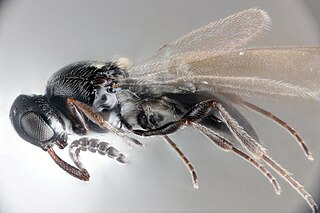
The Megaspilidae are a small hymenopteran family with 13 genera in two subfamilies, and some 450 known species, with a great many species still undescribed. It is a poorly known group as a whole, though most are believed to be parasitoids, and a few hyperparasitoids. Many are found in the soil, and of these, a number are wingless.
Jean-Jacques Kieffer was a French naturalist and entomologist who specialised in the study of parasitic insects. Educated as a priest, Kieffer taught natural science in Bitche, Lorraine while working on the description and classification of insects. His work and publications later became a predominant source of description and classification for entomologists in the early 20th century, in particular with regard to parasitoid wasps, midges, and mosquitos.
Calliscelio is a parasitoid wasp genus which contains two species, C. elegans and C. teleogrylli.
Anteris is a genus of wasps in the family Platygastridae. There are about 15 described species in Anteris.

Synopeas is a genus of parasitoid wasps in the family Platygastridae. There are about 400 described species in Synopeas.
Oethecoctonus is a genus of parasitoid wasps in the family Platygastridae. There are about six described species in Oethecoctonus.
Habroteleia is a genus of parasitic wasps in the family Platygastridae. There are about 9 described species in Habroteleia.
Habroteleia ruficoxa, is a species of wasp belonging to the family Platygastridae. It is found in Philippines.
Habroteleia salebra, is a species of wasp belonging to the family Platygastridae. It is described from Papua New Guinea and Indonesia.
Habroteleia soa is a species of wasp belonging to the family Platygastridae. It is the most geographically disjunct member of the genus, which is separated by other members by the Indian Ocean. It is found in Papua New Guinea and Indonesia.

Trichacis is a genus of parasitoid wasps in the family Platygastridae. Members of this genus have a tuft of setae on the mesoscutellum and transverse striae or rugulae above the antennae. They are parasitoids of Cecidomyiidae, although the hosts of most species remain unknown.

Idris is a genus of parasitic wasps in the family Platygastridae, containing about 160 described species. This genus is part of the tribe Baeini, which are egg parasitoids. Members of the genus Idris are mostly parasitoids of spider eggs, but at least one member of the genus uses stink bugs as hosts.
Amblyaspis is a genus of parasitoid wasps belonging to the family Platygastridae.
Anopedias is a genus of parasitoid wasps belonging to the family Platygastridae.
Isostasius is a genus of parasitoid wasps belonging to the family Platygastridae.
Leptacis is a genus of parasitoid wasps belonging to the family Platygastridae.
Marshalliella is a monotypic genus of wasps belonging to the family Platygastridae. The only species is Marshalliella oxygaster.
Paridris is a genus of wasps belonging to the family Platygastridae.
Sparasion is a genus of wasps belonging to the family Sparasionidae, within the superfamily Platygastridae. The genus has specimens widespread in Eurasia, Africa, and temperate North America.



